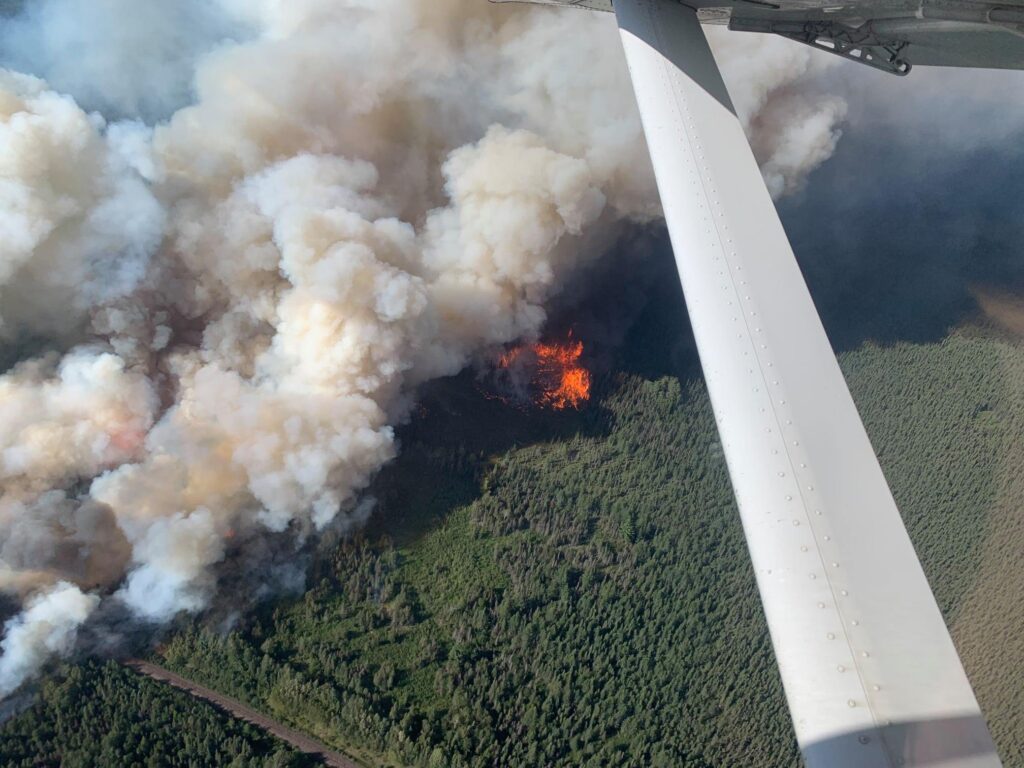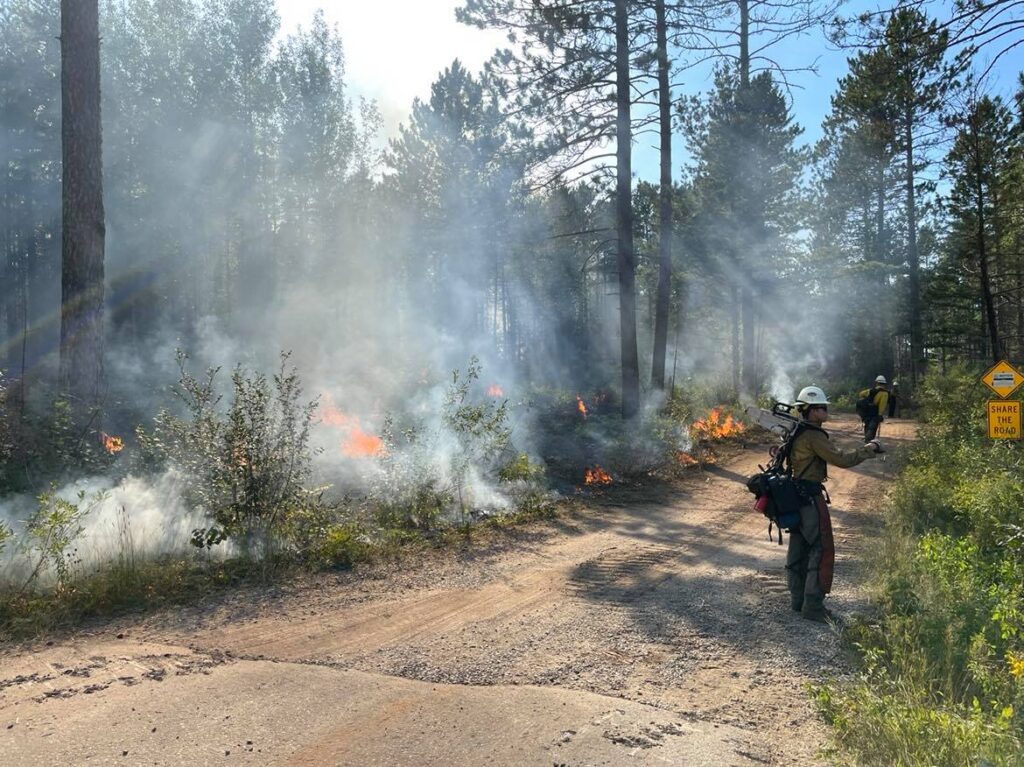
A new series of articles published by the Star Tribune newspaper examines the issue of wildland fire in northeastern Minnesota. On the heels of this year’s Spice Lake Fire, the Greenwood Fire in 2021, new understanding of Indigenous fire practices, ongoing drought, spruce budworm outbreaks, climate change connections and more, the reporting features numerous perspectives and new information.
The three pieces concern prescribed fire, wildfire management, and safety tips for visitors to areas with high fire risk.
“The climate is changing and the world’s boreal forests, which the BWCA forest is, are one of the most flammable forest types in the world,” University of Minnesota forestry professor Lee Frelich told Dennis Anderson.
Frelich added that the annual area burned by forest fires has been increasing in recent years, but the number of individual fires has stayed level. Each fire is bigger because fuels are warmer and drier.

A history of fighting fire with fire
Longtime outdoors columnist and editor Anderson offered an in-depth report on the latest thinking in how to manage fire. He shares how recent research has shown that native people once frequently burned large areas of what’s now the Boundary Waters Wilderness, but the practice has been halted for more than a century, and the forests are worse for it.
Turning to Lane Johnson, researcher at the University of Minnesota’s Cloquet Forestry Center, Anderson reported that archaeologists and other scientists have found historic evidence of frequent, low-intensity fires in many parts of the lake country now designated as wilderness.
“Those long-ago people living in what is now the BWCA not only endured fire, Johnson said, they regularly set strategically placed fires,” Dennis Anderson wrote. “Often these were on south-facing, pine-cluttered points of land they inhabited — the same points that BWCA paddlers seek out today for their Northwoods beauty and for the breezy, often bug-free campsites they provide.”
Johnson said that fires were traditionally set to remove brush that would be highly combustible in the event of an intense fire, as well as to create good habitat for blueberries, raspberries, and wild game. The fires also helped preserve white pines for centuries, as low-intensity burns toughened the bark against large blazes.
Rethinking wilderness rules
Very little prescribed fire is used within the borders of the federally-designated Boundary Waters Canoe Area Wilderness, in part because of laws and regulations. Wilderness advocates have long supported a hands-off management approach, in line with the 1964 Wilderness Act’s concept of “untrammeled.” But at least one such advocate says his thinking has changed.
“Forest Service provisions that prohibit the use of prescribed fire for wildlife or vegetation enhancement should be amended in light of recent studies showing the use of aboriginal burning,” Chuck Dayton told Anderson. “This would be consistent with the history of the wilderness before the arrival of Europeans, and is necessary to preserve the BWCA wilderness as we now know it.”
Dayton, now 84 years old, who has been involved in legislative and legal efforts to protect the Boundary Waters for much of his life, explained that confronting climate change and maintaining healthy forests had also influenced his opinions.

Coordinated responses
In the second article, outdoors reporters Bob Timmons and Tony Kennedy cover Minnesota’s wildland fire response people, organizations, and systems. With recent high-profile fires, the carefully coordinated efforts of leaders, firefighters, and others have been critical in safe management of out-of-control fires.
“The work is shared by the Forest Service, the state Department of Natural Resources, the Bureau of Indian Affairs, the National Weather Service, the U.S. Fish & Wildlife Service, the National Park Service, local fire departments, and others,” Timmons and Kennedy write. “They’re unified by the Minnesota Interagency Fire Center (MIFC) in Grand Rapids.”
For the recent Spice Lake Fire, burning in a difficult-to-access location with dry conditions and fuel, an intense response was put in action. In addition to Minnesota’s firefighting aircraft dropping water on it, and assigning numerous people and resources to the fight, national Hot Shot firefighters crew raced to northern Minnesota from Montana and elsewhere to quickly encircle the flames with firebreaks that contained it before it could get too big to handle.
Besides fighting the fires intensively, the Forest Service has also changed its practices in closing the wilderness, after several visitors were nearly trapped by, and half a dozen Forest Service rangers barely survived, the 2011 Pagami Creek Fire.
Learning and changing practices
“As soon after that as I could, I quit the Forest Service,” Todd Stefanic said. Stefanic was one of the rangers trapped on Lake Insula. “I think about that fire all the time. When they finally got us out of there and back to Ely, they told us not to talk to the media. They didn’t even ask us if we were OK. There were a lot of mistakes made in managing that fire.”
The trapped rangers were all forced to shelter on or in lakes, an option the Forest Service long assumed was feasible. Their harrowing experiences caused the agency to discard the strategy, and today is much more proactive about closing parts of the wilderness it deems threatened by a fire. Forest Service staff say part of the reason for the Pagami Creek incidents was due to concerns about disrupting wilderness visitors and upsetting outfitters. Today they prioritize safety.
Echoing Anderson’s article, the piece quotes Superior National Forest supervisor Tom Hall as saying their decisions about fighting fires are often influenced by the Boundary Waters’ wilderness status. As fire is an essential natural process, and a threat to public safety, the decisions can be complex.
“So how do you balance those things inside the wilderness, knowing that we are trying to have the minimum tool, the minimum impact in there as well?” Hall asked.
The third piece is a brief overview of good practices to stay safe in fire country. It includes guidance to have ways to receive weather and fire alerts, how to watch the weather and conditions, and tips like bringing face masks in case of smoky air. It also covers rules for preventing fires, such as ensuring campfires are out cold before leaving them.
More information:
- Can the BWCA be saved from fire — by fire? – Star Tribune
- Keeping BWCA paddlers safe: How agencies have partnered to improve firefighting up north – Star Tribune
- How to prepare in wild country where fire is a risk – Star Tribune

